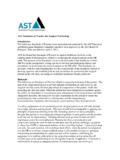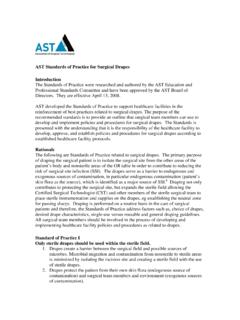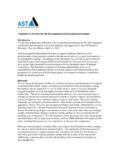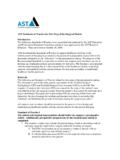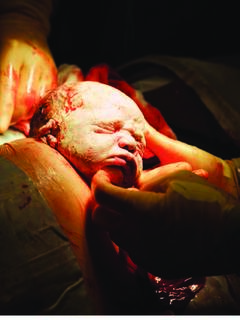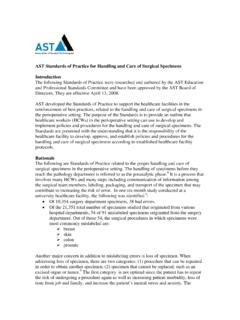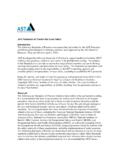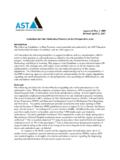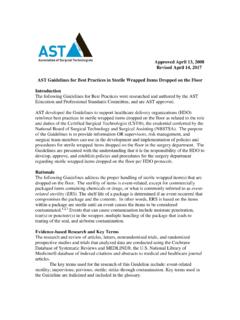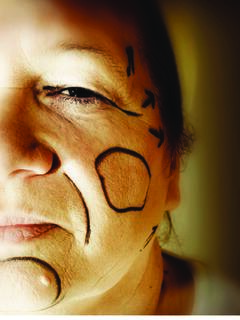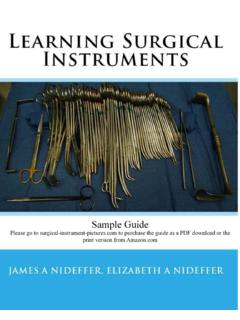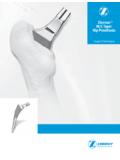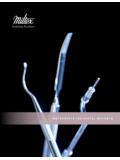Transcription of Standards of Practice for Patient Identification, …
1 Standards of Practice for Patient identification , correct Surgery Site and correct surgical Procedure Introduction The following Standards of Practice were researched and written by the AST Education and Professional Standards Committee and have been approved by the AST Board of Directors. They are effective October 27, 2006. AST developed the following Standards of Practice to provide support to healthcare facilities in the reinforcement of proper surgical Patient identification , and confirmation of the correct surgery site and procedure in the perioperative setting. The purpose of the Standards is to provide an outline that the surgical team in the perioperative setting can use to develop and implement policies and procedures for surgical Patient identification , and confirmation of the correct surgery site and procedure.
2 However, AST refers healthcare providers to The Joint Commission statements in the document National Patient Safety Goals for definitive guidance on improving the accuracy of Patient identification , correct surgery site and procedure, and developing and implementing policies and procedures. The Standards are presented with the understanding that it is the responsibility of the healthcare facility to develop, approve and establish policies and procedures for identification of the surgical Patient , and confirmation of the correct surgery site and procedure according to established healthcare facility protocols. Rationale The following are practices related to the proper identification of the surgical Patient , verification of the correct surgery site and surgical procedure by the surgical team.
3 There are many instances when Patient misidentification, wrong site surgery and wrong Patient can occur, including invasive procedures, medication administration, transfusion of blood products, and matching pathology specimens to the correct The practices are meant to contribute to the efforts of Patient safety and reduce the risks of Patient errors. Standard of Practice I. The Patient should have at least two corroborating Patient identifiers as evidence to confirm identity. 1. The use of two Patient identifiers improves the reliability of the Patient identification process and decreases the chance of performing the wrong procedure on the wrong Patient . Additionally, the use of two Patient identifiers is necessary in the instances of a name Patient alert because two (or more patients ).
4 Have the same name that can be spelled the same, close to being spelled the same and/or pronounced the same. Examples of acceptable Patient identifiers include9: A. Name B. Assigned identification number C. Telephone number D. Date of birth E. Social security number F. Address G. Photograph 2. The Patient 's room number should not be used as a Patient identifier; room numbers are not person-specific identifiers, since patients can be moved from room to Standard of Practice II. All patients undergoing a surgical procedure should wear an identifying marker. 1. identification markers on the Patient will prevent wrong Patient surgery. 2. identification markers on the Patient will prevent wrong-procedure and wrong-site surgery. 3. identification markers can include the following: A. Wristband as identification bracelet B.
5 Wristband with unique bar-coded Patient identifier C. Radio frequency identification (RFID) marker3. 4. Healthcare facilities should still be aware that the reliance on wristbands for identification of the correct Patient has, obviously, not eliminated the problem of Patient misidentification. surgical technologists should still follow all other Patient identification policies to prevent an error. surgical technologists should be aware of the six most common types of wristband errors as an aid in foreseeing the hazards associated with wearing a wristband6: A. Wristband is not present B. Wrong wristband, ie another Patient 's wristband C. Presence of more than one wristband, and conflicting information is written on both. D. Partially missing information on the wristband E. Erroneous information on the wristband F.
6 Written information on wristband is illegible G. Patient 's name is written the same, written close to the same, and/or pronounced the same as another Patient 's name 5. surgical technologists should avoid removing the wristband. A. The wristband should be placed on the wrist of the non-operative/non- affected side of the body. B. If the wristband must be removed, it is recommended that it be placed with the Patient chart in order to be immediately replaced on the wrist at the end of the procedure, or a new wristband is obtained and placed with the Patient chart for immediate placement on the wrist. Standard of Practice III. All patients undergoing a surgical procedure must be properly identified by the surgical team members prior to transporting the Patient to the surgery department.
7 1. All surgical team members should recognize that performing an invasive procedure on the wrong Patient is a possibility that always No healthcare facility, small or large, is immune from human errors, poor communication and lack of To reduce Patient identification errors is not accomplished by trying to perfect human performance, but rather by improving the system where healthcare providers work. The human condition can't be changed, but the conditions under which people work can be The following recommendations are intended to reduce the risk of performing an invasive procedure or surgery on the wrong Patient . A. The following are recommended times for verification of Patient identity and surgical procedures: (1) When the surgery is scheduled (2) When the Patient is admitted to the healthcare facility (3) Anytime the Patient is transferred to another caregiver (4) Prior to sedation (5) Prior to the patients entry into the operating room B.
8 The following are recommendations for the identification of the conscious, competent Patient prior to the start of the surgical procedure1: (1) The surgical technologist should address the Patient using his/her full name and introduce himself/herself, including job title or position. This will aid in lessening the anxiety of the Patient . (2) Patient should be asked to say his/her name, the surgical procedure to be performed, and location of the operation. (3) The Patient 's name and hospital-assigned identification number on the surgery schedule and transfer slip should correspond with the information on the Patient 's wristband. (4) The information on the Patient 's wristband should correspond with the information in the Patient 's chart. (5) Verify that the procedure listed and described on the informed consent in the Patient 's chart is the same procedure that the Patient verbally stated.
9 (6) Confirm that the correct procedure is on the operating room schedule. C. The following are recommendations for the identification of the mentally incapacitated patient1: (1) Verify that the correct Patient is being taken to the operating room by asking a family member or designated representative the Patient 's name. (2) Verify the information on the Patient 's wristband is the same as the information in the Patient 's chart. (3) The Patient 's name and hospital-assigned identification number on the surgery schedule and transfer slip should correspond with the information on the Patient 's wrist band. (4) Verify that the procedure listed and described on the informed consent in the Patient 's chart is the same procedure listed on the surgery schedule. (5) Confirm with the family member or designated representative the procedure that is expected to be performed, as well as location of the operation and verify this matches up with the informed consent.
10 D. The following are recommendations for the identification of a minor patient1: (1) Complete the recommendations for an alert, oriented Patient . (2) Confirm the minor Patient 's name with the parent or legal guardian, the procedure to be performed and location of the operation. E. If, at any point, the verification process fails to confirm the correct Patient , correct procedure and/or correct site, the surgeon should be notified and no action taken in transporting the Patient into the operating room until the verification is accurate. Standard of Practice IV. Verifying the correct surgical procedure and site is the responsibility of the surgical team members. 1. Methods of proper confirmation of the surgical procedure and surgical site identification should include, but are not limited to, the following: A.
